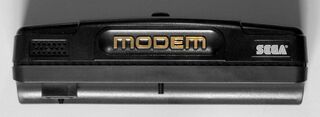Mega Modem
From Sega Retro

| |||||||||||||||
| Mega Modem | |||||||||||||||
|---|---|---|---|---|---|---|---|---|---|---|---|---|---|---|---|
| Made for: Sega Mega Drive | |||||||||||||||
| Manufacturer: Sega | |||||||||||||||
|
The Mega Modem (メガモデム) is a modem for the Sega Mega Drive released in 1990 exclusively in Japan. It allows a Mega Drive owner to connect his console to the Internet through services provided by Sega. Ultimately, three services made use of the modem: the Mega Anser, Sega Meganet, and Sansan (there have been other banking services: Naisu-kun Mini and Osaka Bank My Line; and Sumisei Home Tanmatsu, which appears to be a life insurance system — whether or not they use Mega Anser is unconfirmed).
The modem connects to the back of a Mega Drive through the third DE-9 expansion port; consequently, it will only connect to a Model 1 Mega Drive. Furthermore, two models of the Mega Modem are known to exist: one that connects to the Internet through a phone line (which was sold both standalone and with the Meganet's Sega Game Library cartridge) and one that connects through an RS232C cable built into the unit.
TeleGenesis Modem
When the Mega Drive was released in North America as the "Sega Genesis" in August 1989, Sega of America drew attention to a localised variant of the Mega Modem, the TeleGenesis Modem. Originally set to debut shortly after the console, the device was pushed back to July 1990 and given a price tag of around $100[1].
While the accessory was thought to be the same as its Japanese counterpart, it was marketed as offering competitive online play across towns and cities nationwide[2] rather than something akin to Sega Meganet. However, Sega withheld selling the peripheral until "quality modem-based entertainment software" was available in the region[3], which presumably never occurred. By the time of Japanese launch in November, Sega of America were still undecided as to whether to press ahead with a localised variant[4].
The concept of playing video games competitively over the internet did not become a mainstream feature of gaming until well into the 2000s.
Physical scans
External links
References
